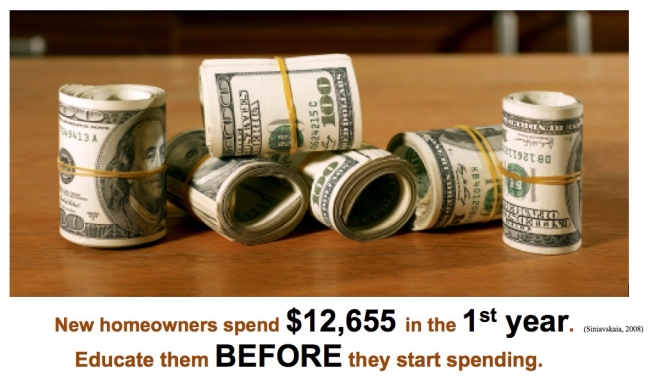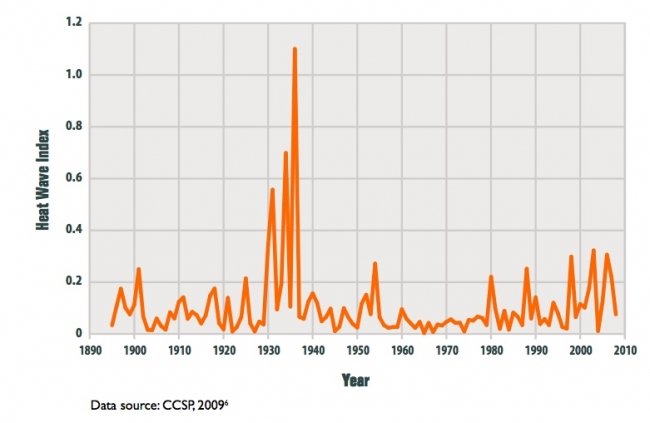"Kitchen Table" Strategy: Home Inspectors Driving Demand for Home Improvements
“Although the home performance industry's delivery of comprehensive energy and comfort improvements
has been growing across the country, it continues to struggle in
creating consumer attention and demand. Our industry's delivery timing
is off. We are not yet engaging the homeowner at their sweet spot of
making improvements -- right after they purchase a home! This is when
they move most aggressively with all sorts of home improvement projects
-- and, unfortunately, seldom with any concerns of energy use. I
strongly believe the home inspection industry is in a prime
position to educate new homeowners on the long-term value of a
high-performing house. There are millions of homes sold each year. Home
inspectors are there; home performance is not. This must change."
-- Chandler von Schrader, ENERGY STAR Home Improvement Program
"Kitchen Table" Strategy
Nearly 10,000 times every day, home inspectors sit at kitchen tables with new homeowners -- BEFORE they even buy the house -- and educate them about:
-
how the home works;
-
how to maintain it; and
-
how to save energy.
Home inspectors across the U.S. are right now talking to potential clients of home energy professionals. This kitchen table strategy connects them. Energy education ultimately can create demand.1
“The Department of Energy is working to develop a strong home retrofit industry. We are creating a state-of-the-art tool that home inspectors can use on a handheld device to assess energy-savings potential and identify the most effective investments to drive down energy costs.”
-- U.S. Secretary of Energy Steven Chu2
 Meet Mr. and Mrs. Baker
Meet Mr. and Mrs. BakerMr. and Mrs. Baker just found their dream home and, with the help of their home inspector and real estate agent, they are going to become new homeowners.
However, they’re unaware:
- that their house is actually wasting money;
- what their home actually costs to operate; and
- how to save money by saving energy.
And they are about to spend thousands of dollars on home improvements and remodeling without any regard to home energy.
 3
3 “New homeowners expect climate comfort in their dream homes. Most home energy systems are inefficient; i.e. uncomfortable and costly. Home energy contractors make homes climate comfortable. Pairing home inspectors with home energy contractors is a brilliant way to connect a comfort problem with a comfort solution.”-- Stephen Michael Self, Sustainable Ideas
How can millions of other homeowners, like the Bakers, be persuaded to divert their valuable time and resources into upgrading their homes to eliminate energy waste, avoid high utility bills, and spur the economy?
Answer: Target New Homeowners
We need to:
- target new homeowners;
- educate them about energy efficiency; and then
- connect them to their local home energy professionals.
Why New Homeowners?

Because that's where the money is.
We know two facts:
- FACT #1: New homeowners are eager to start remodeling projects.
- FACT #2: It is nearly impossible to sell energy upgrades to existing homeowners after they've spent money on remodeling projects.3
$12,655:
The typical new homeowner spends $12,655 in the first year.5
A home purchase triggers a series of additional spending on appliances
and renovation activities that exceed typical spending levels of
non-moving owners, and spending persists for years after moving in.6
$8,500:
The Bakers will spend an estimated $8,500 in the first six
months after moving in, and nearly $65,000 over the first ten years of
their home ownership.
Remodeling:
500,000 remodeling projects occur every year, and energy-upgrade measures could be easily incorporated during them.
By their nature, home energy upgrades require substantial
up-front investment in exchange for savings realized over the lifetime
of the deployed measures. Therefore, it is critical to educate new homeowners about energy efficiency and home energy upgrades BEFORE they spend money.
General Home Buyer Statistics
- 99% of all REALTORS® recommend a home inspection
- most home buyers hire a home inspector7
- over 80% of all homes sold are existing homes
- typical home purchased is a detached single-family home, about 2,000 sq ft in size, built in early 1990's
- nearly 40% of all home buyers are first-time buyers
- most home buyers were married couples
- median household income of buyers was about $80,000-$100,000
- heating and cooling costs are important to most buyers8
 9
9 2 Million New Buyers
Over 2,000,000 times a year, home inspectors sit at kitchen
tables with new home buyers, home sellers and their real estate agents,
and the conversation over coffee is as much about home energy as it is
about the home's condition.
Millions of Clients
Home inspectors also have a database of information on
millions of their recent home-buying clients with whom they have
positive, long-term relationships.10
Leveraging an Existing Workforce
Leveraging home inspectors’ existing relationships with new home buyers
and real estate agents to deliver program messages can be a
cost-effective way to increase demand for comprehensive energy upgrades.
The key to a successful home performance program, and the
continued success of the home energy-upgrade industry, rests upon
leveraging the existing, national workforce of trusted, third-party
(neutral) home inspectors who can find and reach new homeowners
(consumers), provide education using skilled communication, and motivate
them to take effective energy-saving action.
Workforce Guideline Recommendations
Home inspectors make report recommendations based, in part,
on the U.S. Department of Energy’s Workforce Guidelines for Home Energy
Professionals.11 These standard work specifications
define the minimum requirements for high-quality installations of
energy-efficiency measures by qualified contractors.
Home inspectors can help millions of homeowners find the
qualified contractors -- home performance contractors -- to do the right
work the right way.
Trusted Home Inspector, Trusted Referrals
There are several benefits to homeowners for hiring home energy contractors.
The Bakers will enjoy:
- utility bill savings of 20% or more;
- less drafts and more comfortable rooms;
- work performed by specially trained contractors;
- third-party quality assurance to make sure the work gets done right; and
- reduced greenhouse gas emissions to protect the environment.
A referral is a transfer of trust. Trusted home inspectors can help refer their clients to home performance contractors.
 13
13However, homeowners do not:
- see the value of getting their home assessed by an energy auditor,14
- nor trust recommendations made by home performance contractors or salespersons.15
Homeowners Trust Third-Party Advisors
Home inspectors play the role of the
trusted, third-party advisors positioned to empower homeowners
with accurate information so they can make informed decisions.16
Home inspectors address homeowners' concerns while also helping them
find qualified contractors to perform home improvements and home energy
upgrades. The home inspector's neutrality adds to the credibility of his
recommendations, which engenders trust between himself and the
homeowner.
Training: Sales, Communication and Customer Service
Home inspectors are trained in talking to
homeowners. They speak their language. InterNACHI-certified home
inspectors are required develop the skills necessary to effectively
communicate to homeowners. Certified Professional Inspectors® are
required to take courses on sales, communication and customer service.17
This online training is available to all home energy
professionals, contractors, inspectors and auditors from InterNACHI.
Continuous learning and mentoring opportunities are available to home
energy professionals through InterNACHI's online and live classroom
training and education curriculum.
Building science is complex and over-whelming to
home owners. But home inspectors are trained to make things simple and
clear to understand.
The home energy upgrade industry does not
necessarily need more training and certification of contractors and
auditors, but, rather, more home inspectors educating their clients
about home energy upgrades.
 18
18Less than 25,000
Not enough work has been done. In 2009, less than 25,000 Home Performance with ENERGY STAR jobs were completed.19
Many American Recovery and Reinvestment Act
(ARRA) and utility customer-funded, residential energy-efficiency
programs are committed to developing a sustainable workforce of home
energy professionals who will serve the market long after ARRA funds are
spent. Much of the training has been focused on building science
education and technical certification (e.g., BPI, RESNET). However, the
increase in home performance contractors with technical training and
certification has not produced a proportional increase in the amount of energy upgrade work.
The importance of engaging and educating the public in energy efficiency has never been greater. 20
Programs that succeed in performing
a significant number of energy upgrades will leverage home inspectors
as the program’s main way of reaching and educating new homeowners.
Public funding will not last
forever, and in a self-sustaining market, home inspectors will be the
primary agents in reaching and educating homeowners about home energy
efficiency.
Therefore, the end-game for market transformation must leverage certified home inspectors.
Leveraging Home Inspectors
Home inspectors, more than any other party:
- are the people sitting across the kitchen table with millions of new homeowners every year talking about home energy efficiency; and
- have access to consumers who may initially want to purchase "bling," but may be open to other improvements.
But the Bakers don't want to be overwhelmed with a number of
metrics telling them how good or bad their home is regarding its energy
efficiency. They need to be provided with a simple report and a single
home energy label in a context they can understand and assign some
actionable value to.
Increasing awareness of energy use and knowledge about specific energy-saving opportunities would enable homeowners to act more swiftly in their own financial interest.21
Through InterNACHI’s program, home inspectors use a simple tool that helps homeowners to easily understand the fundamentals of home energy efficiency. It’s called the InterNACHI Home Energy Report. This software is online, free, and available to all home inspectors and contractors.
Energy Auditors
Increased education and awareness of energy efficiency is a necessary
component of a holistic approach to creating demand. It can be highly cost effective when home inspectors are
leveraged.

Past research studies have shown satisfaction with energy
auditors has been low for consumers. Clearly consumers are expecting a
high level of education, information and tangible solutions from energy
auditors. This suggests that to date, there has been a disparity in the
expectation and actual derived value for consumers.22 Meaningful consumer education must start not with an auditor, but with a home inspector.
In 2012, there will be more than 2.5 million new homeowners educated by their home inspectors in ways that are meaningful.23
Home Maintenance Book
Home inspectors are putting this home maintenance book in the hands of new homeowners every day.
The InterNACHI Home Maintenance Book helps homeowners:
- make smart decisions BEFORE spending money on their home improvement projects; and
- plan a strategy for making smart home upgrades that maximize energy efficiency and save the most money.
The most affordable way to accurately identify 'green' MLS features
leverages the existing workforce of certified home inspectors.
- Listing agents are using home inspectors to accurately list the 'green' features.
- Buying agents are using home inspectors to identify the 'green' features and the House Energy Score during a Home Energy Inspection.
Financing requires lenders that are willing, lenders require appraisals to
underwrite their loans, and appraisers need data to support their
valuations. Appraisers look to the Multiple Listing Services
(MLS) and the local market for that data.
InterNACHI is developing new, creative approaches in the
development and promotion of Green MLS data fields on a national scale.
Having 15,000 home inspectors accurately identifying, capturing and
providing data on 'green' features of millions of homes is a powerful
way to promote the adoption of a standardized Green MLS.
For more information about home inspectors and the Green MLS, visit us at www.nachi.org/green-mls.
 24,25
24,25 The Time to Act is Now
Improving energy efficiency on a large scale is a challenge
we can't afford not to take. While you were reading this information,
Earth warmed up even more.24,25

Most climate scientists agree the main cause of the current global
warming trend is human expansion of the "greenhouse effect" -- warming
that results when the atmosphere traps heat radiating from Earth toward
space.26

Increased frequency and severity of heat waves can lead to
more illness and death, particularly among older adults, the young, and
other vulnerable groups.27

Homeowners can take simple steps to eliminate drafts, keep their home more comfortable year
round, save energy that would otherwise be wasted, and reduce greenhouse
gas emissions. Greenhouse gas emissions can be reduced through simple measures
like changing light bulbs. If every American home replaced just one light bulb with a light bulb
that's earned the ENERGY STAR, we would save enough energy to light 3
million homes for a year, save about $600 million in annual energy
costs, and prevent 9 billion pounds of greenhouse gas emissions per
year, equivalent to those from about 800,000 cars.
Nationwide Effort
A nationwide effort to improve the efficiency of America’s 130 million homes can:
- create jobs;
- reduce energy waste;
- save our businesses and institutions money; and
- reduce our dependence on foreign oil.

Our homes devour 23% of all U.S. energy. The
U.S. consumes more energy than anyone else on the planet – about 20% of
the total global demand. The nation's 130 million households and more
than 74 billion square feet of commercial floor space account for:
- 42% of U.S. primary energy consumption;
- 39% of all U.S. greenhouse gas emissions; and
- 74% of all U.S. electricity consumption.28, 29
Supporting the home performance industry will spur economic
growth. Consumer demand for home energy upgrades will create hundreds of
thousands of desirable green American jobs while stimulating the
manufacture of building materials.30
The time is now for all stakeholders in the
energy upgrade industry, including the Environmental Protection Agency
(EPA) and the Department of Energy (DOE), to recognize and leverage the
existing workforce of certified home inspectors.
Join
One kitchen table at a time, home inspectors and home energy
professionals can work together to make millions of U.S. homes and
buildings more energy-efficient.
InterNACHI, the International Association of Certified Home
Inspectors, is the world’s largest organization of home inspectors who
perform nearly 10,000 property inspections every day. As the home
inspection industry leader, InterNACHI supports policies that will
create the foundation for a sustainable and scalable home energy upgrade
market.
Join InterNACHI by visiting www.nachi.org/join.
1. Burrows, Kristi. Smart Energy Program Consumer Study, Understanding Consumer Lifestyle Drivers and Energy Attitudes as Motivation, Best Buy Consumer Insight Unit, September 2010.Best Buy - Home Energy Mangement Report.pdf
2. Chu, Steven, Op-Ed on Energy Efficiency from the World Economic Forum: http://energy.gov/articles/secretary-chu-op-ed-energy-efficiency-world-economic-forum. March 16, 2011.3. Siniavskaia, Natalia, PhD., “Spending Patterns of Home Buyers. Special Studies.” December 4, 2008.4. Lawrence Berkeley National Laboratory, “Driving Demand for Home Energy Improvements.” September 2010.5. Siniavskaia, op. cit.6. Siniavskaia, op. cit.
7. National Association of REALTORS®. Profile of Home Buyers and Sellers 2011.8. Market Enhancement Group. National Association of REALTORS® Home Inspection Study. 2001.9. National Association of REALTORS®, Pending Home Sales Index. http://www.realtor.org/research/research/phsbackground10. Housing and Urban Development (HUD), “Annual Sales of Existing Homes .” U.S. Housing Market Conditions. Exhibit 7. Existing Home Sales 1970-Present. November 2010. Page 68.
11. U.S. Department of Energy (DOE). Workforce Guidelines for Home Energy Professionals. http://www1.eere.energy.gov/wip/retrofit_guidelines.html.12. InterNACHI, Online Training and Education Curriculum, Required courses for home performance contractors who understand the house as a system, “The House as a System” https://www.nachi.org/house-as-a-system.htm, "Energy Movement" https://www.nachi.org/house-as-a-system.htm, "Comfort and Climate" https://www.nachi.org/comfort-climate.htm, "Indoor Air Quality" https://www.nachi.org/indoor-air-quality-course.htm. www.nachi.org/education.13. U.S. Department of Energy (DOE). Report, "Motivating Home Energy Improvements. Focus Groups for the U.S. Department of Energy.” 2010.14. Lawrence Berkeley National Laboratory (LBNL). “Contractor Sales Training: Providing the Skills Necessary to Sell Comprehensive Home Energy Upgrades.” August 17, 2011.15. DOE, Report, op. cit.
16. InterNACHI. International Home Inspector Code of Ethics: https://www.nachi.org/code_of_ethics.htm.17. InterNACHI. "Sales, Customer Service and Communication for Inspectors." Free, online training course for property inspectors provided by InterNACHI. A required course for all InterNACHI-certified home inspectors: https://www.nachi.org/customer-service-communication.htm.18. U.S. Department of Energy (DOE). Buildings Energy Data Book. Table 9.1.2. http://buildingsdatabook.eren.doe.gov/TableView.aspx?table=9.1.2.19. DOE, Table, op. cit.20. DOE, Table, op. cit.21. McKinsey & Company. McKinsey Global Energy and Materials. Unlocking Energy Efficiency in the U.S. Economy. July 2009.22. Burrows, op. cit.23. InterNACHI. Number of inspections performed, Vision and Mission Statement: https://www.nachi.org/vision-mission-statement.htm.
top of page24. Remer, Lorriane. NASA, Earth Observatory, Global Temperatures 2000 to 2009. http://earthobservatory.nasa.gov/Features/WorldOfChange/decadaltemp.php25. Lee, David. DOE's Building Technologies Program Residential Supervisor. "3-7℉ increase by 2100". DOE, Energy Efficiency: DOE Priorities, ACCA Green Conference, October 2010.26. National Aeronautics and Space Administration (NASA). Global Climate Change, Causes.27. U.S. Environmental Protection Agency (EPA). Climate Change Indicators in the United States. p. 58.
28. U.S. Energy Information Administration. Pie chart, Annual Energy Review 2009, and Monthly Energy Review (June 2011), preliminary 2010 data.29. Crawley, Drury. Commercial Building Research Team Lead, Building Technologies Program, Office of Energy Efficiency and Renewable Energy, U.S. Department Of Energy. Testimony: The Building Technologies Program.30. Goldstein, Benjamin. Rebuilding America, A National Policy Framework for Investment in Energy Efficiency Retrofits. August 2009.





